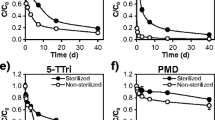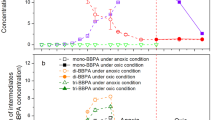Abstract.
The fate of isoproturon {N,N-dimethyl-N′-[4-(1-methylethyl)phenyl]urea} in biobeds with and without inoculation with the white rot fungus Phanerochaete chrysosporium was studied. Total extractable isoproturon, its metabolites and formation of non-extractable residues were evaluated. Studies with 14C-isoproturon were also included. A strong decrease in isoproturon was observed in non-inoculated biobeds. Total extractable isoproturon decreased by 76% after 100 days. The decrease was even larger in biobeds inoculated with the white rot fungus P. chrysosporium. After 28 days, total extractable isoproturon decreased by 78%, and after 100 days >99% had disappeared in the inoculated biobeds. However, the studies with 14C-isoproturon showed that 30% of the initially recovered 14C-isoproturon remained in the non-inoculated biobeds as non-extractable residues. As no studies with 14C-isoproturon were performed in inoculated biobeds, it is unclear if the higher rate of disappearance was due to higher biodegradation or higher formation of bound residues.
Similar content being viewed by others
Author information
Authors and Affiliations
Additional information
Electronic Publication
Rights and permissions
About this article
Cite this article
von Wirén-Lehr, S., del Pilar Castillo, M., Torstensson, L. et al. Degradation of isoproturon in biobeds. Biol Fertil Soils 33, 535–540 (2001). https://doi.org/10.1007/s003740100368
Received:
Issue Date:
DOI: https://doi.org/10.1007/s003740100368




